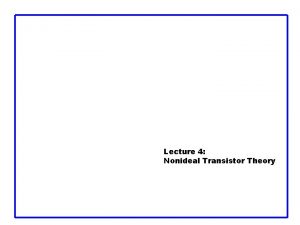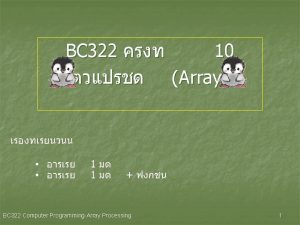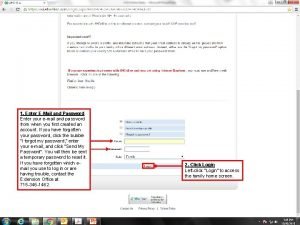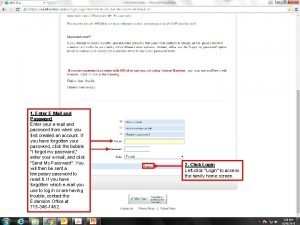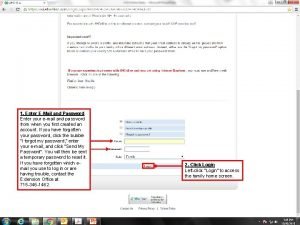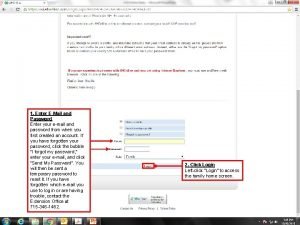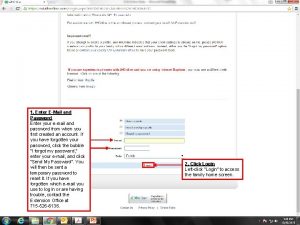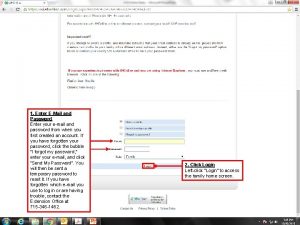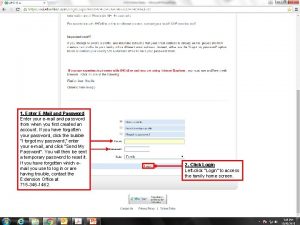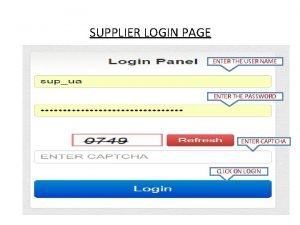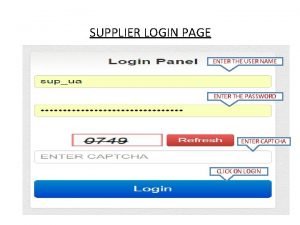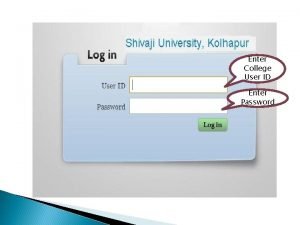The Solution module Use Solution to enter nonideal






































- Slides: 38

The Solution module Use Solution to enter non-ideal mixing properties in your private solution databases. Table of Contents Section 1 Table of Contents Section 2 The Solution Module Section 3 Toolbars and menus Section 4 Obtaining information on an existing database List of Solution Phases in a database List of Gibbs Energy Expression of GHSERAL Function Inspection of the phase SGTE_1 alias FCC_A 1 Section 5 Generation of a database (Example: Na. Cl-Sr. Cl 2 liquid) Page 5. 1 Data to be entered Page 5. 2 Creation of a Private Solution Database USERSOLN Page 5. 3 Creation of a Solution Phase (Simple Polynomial Solution) Page 5. 5 Page 5. 6 Page 5. 8 Basics of entering of Components, Lists and Parameters Entering the standard Gibbs energy of the components Alternate way to enter thermodynamic data (continued) NOTE: Use the HOME/Pos 1 button to return to the table of contents. Solution 1. 1 www. factsage. com

The Solution module Table of Contents (continued) Generation of a database (Example Na. Cl-Sr. Cl 2 liquid) (continued) Page 5. 9 Entry of Excess Mixing Properties data (Solution Polynomial) Page 5. 11 Summarize, Edit and View the Excess Parameters Page 5. 12 Entry of Component Lists Page 5. 13 Inspecting the Solution File Page 5. 14 Saving the Solution Database Section 6 General considerations on solution data Page 6. 1 First example from Factdata/Examsoln. dat Kohler, Toop and Muggianu interpolation methods Page 6. 3 Second example from Factdata/Examsoln. dat Page 6. 5 Third example from Factdata/Examsoln. dat Excess terms (Joules/equivalent) Page 6. 8 Fourth example: Fe-Cr data using SGTE format NOTE: Use the HOME/Pos 1 button to return to the table of contents. Solution 1. 2 www. factsage. com

The Solution module Click on Solution in the main Fact. Sage window. Solution 2 www. factsage. com

Toolbars and menus The following two slides explain the use of the Solution module from its Main window. There are three main sub-windows from which information on a the phase tree of a database, detailed information on particular data items, and results of data searches can be read. Furthermore there are several option menus and toolbars available. Solution 3. 0 www. factsage. com

Solution Main Window Treeview Window lists all the databases, solution phases and functions Status Bar: indicate the actual state of your session Information Window provides detailed information on the current item selected in the Treeview Window Immediate Window displays search results, click on an item and the treeview jumps to it The Solution program permits you to enter parameters defining the Gibbs Energy Surfaces of non-ideal solutions. (Data management: creating, listing, loading and modifying databases. ) Solution 3. 1 www. factsage. com

Toolbars and menus Features of the program are accessible through program menu at the top of the window, toolbars and also context menus available by right-clicking on various objects. Solution 3. 2 www. factsage. com

Obtaining information on an existing database The following three slides show information on a particular database that already exists can be obtained using the features of the Solution module. As an example the SGTE solution database was used. Solution 4. 0 www. factsage. com

List of Solution Phases To display the list of solution phases in the “SGTESOLN. dat” database, click on the specific database in the code explorer Treeview Clicking on the column heading sorts the list on that field Right-click on an item for a context sensitive menu (other options if many items are selected) Columns displayed are: • • • Phase number: becomes the solution phase number SOLN_N when the database is used by Equilib; Nickname: appears when the database is used by Equilib; Date of creation of the phase; Solution model: code number for the phase type (e. g. , Compound Energy Model); Two lines of description. Solution 4. 1 www. factsage. com

List of Gibbs Energy Expression of GHSERAL Function Context sensitive menu: Entry of a new function can be done by right-click on the corresponding database. Click on «New» and «Function» . Note: GHSERAL has 3 ranges Select You can scroll for other functions You can add, remove or modify the ranges values then press on the update button to save all modifications. Solution 4. 2 www. factsage. com

Inspection of the phase SGTE_1 alias FCC_A 1 Your solution phase is now ready for a new entry or modification Right-click on an item for a context sensitive menu Other options to display The information window is a tabbed display containing details of the currently selected phase in the Treeview Window. Number of tabs displayed and their contents depend upon the solution model chosen. Solution 4. 3 www. factsage. com

Generation of a database (Example: Na. Cl-Sr. Cl 2 liquid) The following fourteen slides show a private solution database is built. As an example the entry of the data for the liquid phase in the Na. Cl. Sr. Cl 2 system are used. The basic data that need to be stored are explained first and in the following thirteen slides the entry of each data item is shown in detail. (This phase has also already been stored in Factdata/Examsoln. dat under the phasename LIQS. You may open and edit this file. ) Solution 5. 0 www. factsage. com

Data to be entered into a User Solution File for a Liquid Na. Cl-Sr. Cl 2 Binary solution using Solution Program Example of use of Solution program Parameter Entry for a simple Type-1 Polynomial Solution Description: Thermodynamic data for binary liquid Na. Cl-Sr. Cl 2 phase Entry: Joules Model: Polynomial Na. Cl(L) XSr. Cl 2(L) Go 2 G Gibbs energy: Go 1 G = (X 1 Go 1 + X 2 Go 2) + RT(X 1 ln(X 1) + X 2 ln(X 2)) + GE Binary Excess mixing terms H = X 1 X 2( -11128. 649 ) + X 12 X 2 ( -9547. 7573) SE = X 1 X 2(- 8. 9242 ) + X 12 X 2(- 8. 92971 ) Hence: GE = X 1 X 2 ( -11128. 649 + 8. 9242 T ) + X 12 X 2 (- 9547. 7573 + 8. 92971 T) Solution 5. 1 www. factsage. com

Creation of a Private Solution Database USERSOLN 1°_ Click on «New» ; «Database…» from the «File» menu. 2°_ Choose a filename and select a directory for your new database. 3°_ Enter a four character nickname and a general description for your database (optional). Solution 5. 2 Different database formats www. factsage. com

Creation of a Solution Phase (Entry for a Simple Polynomial Solution) To create a solution phase: 1°_ Click on «New» and «Solution Phase…» from the «File» menu or the context sensitive menu By the way… Choice of energy units for the session can be changed at any time Solution 5. 3 www. factsage. com

…Creation of a Solution Phase (Input session for the binary Na. Cl-Sr. Cl 2 solution) …To create a solution phase: 2°_ Enter a four-character nicknamefor your new solution phase; 3°_ Select / Identify the solution model; 4°_ Enter a description of your solution phase (2 lines); (Kohler / Toop) interpolation method used for ternary and higher-order systems 5°_ Select the magnetic contributions. Solution 5. 4 www. factsage. com

Basics of Entering Components, Lists and Parameters Right-click on your solution in the information window for a context menu, then click on «Edit» . Note all the tabs are empty because we create a blank solution phase. Solution 5. 5 www. factsage. com

For Na. Cl we enter the standard Gibbs energy of the liquid from the FACT Compound database Retrieval of data for Na. Cl from the main FACT database Na. Cl has 3 phases S 1, L 1 and G 1 The components’ tab provides an example of entering a new component Solution 5. 6 www. factsage. com

For Sr. Cl 2 we enter the standard Gibbs energy of the liquid from the FACT Compound database Retrieval of data for Sr. Cl 2 from the main FACT database Sr. Cl 2 has 4 phases S 1, S 2, L 1 and G 1 Solution 5. 7 www. factsage. com

Alternate way to enter thermodynamic data If G°(added) is defined then: G°Sr. Cl 2 = G°ref (L 1) + G°(added) (If G°ref = 0, you must respect the convention that H° 298 = 0 for elements). The Properties + G(Added) tab displays certain variables for the component and some advanced properties. The G(Reference) tab displays Cp values and other «extended properties» Default values are chosen regarding ”Particles”, “Equivalent”, “Composition limits” and “Acid/Base (Kohler-Toop)” groupings Solution 5. 8 www. factsage. com

Entry of Model Parameters for Excess Mixing Properties (Solution Polynomial) Entry can also be expressed as Redlich-Kister or Legendre Polynomials Brief reminder of how to enter parameters Enter your parameter values then press «Apply» The Gibbs energy of mixing is given by G = RT (X 1 ln X 1 + X 2 ln X 2) + GE Solution 5. 9 www. factsage. com

Entry of the Second Parameter for Excess Mixing Properties of the solution Enter your parameter values then press «Apply» Solution 5. 10 www. factsage. com

Summarize, Edit and View the Excess Parameters A grid showing the existing excess interactions Components, powers and parameters for the selected interaction A Help Window explaining the above entered excess interaction parameters Solution 5. 11 www. factsage. com

Entry of Component Lists Note: In this example, combining the two components into one list is trivial. A solution phase may contain one or more lists of components which have been assessed together to form a multi-component solution. Only the use of such combinations is safe (in Equilib). Solution 5. 12 www. factsage. com

Inspecting the Solution File Note that the parameters (H° 298 , S° 298 , CP) in the expression for G°(ref) , G(added) and G(excess) can also be displayed using other display options. Scroll to display other options Solution 5. 13 www. factsage. com

Saving Solution Database Saving a database can be done by clicking on «Save» from the «File» menu or by pressing the «Save» button. Solution 5. 14 www. factsage. com

Examples of data entries in solution database The following 11 slides show 4 different examples of the data needed to describe non-ideal solutions according to different Gibbs energy models. These files are stored in your Factdata directory in Examsoln. dat. You can open this file using the Solution module in order to see how the data have been entered. The first example shows the data for a simple substitutional solution treated with polynomials in the mole fractions and using the Kohler method for extrapolation into the ternary, here the Liquid Li. Cl-KCl-Cs. Cl Phase. The phase name used in the Factdata/Examsoln. database is Ak. Cl. Solution 6. 0 www. factsage. com

First example from Factdata/Examsoln. dat Thermodynamic Data for Liquid Li. Cl-KCl-Cs. Cl Phase Nickname: Ak. Cl Binary excess mixing terms: Li. Cl-KCl system: Hence: Li. Cl-Cs. Cl system: KCl-Cs. Cl system: Ternary terms: Solution 6. 1 www. factsage. com

Kohler, Toop and Muggianu interpolation methods Kohler Toop Muggianu 1 1 1 c a a p 2 b 3 2 p b c a c p 3 2 b 3 Kohler, Toop and Muggianu methods of including binary polynomial terms in ternary Gibbs Energy Equations. Reference: P. Chartrand A. D. Pelton, «On the choice of “Geometric” Thermodynamic Models» , J. Phase Equilibria, 21, 141 -147 (2000). Solution 6. 2 www. factsage. com

Second example from Factdata/Examsoln. dat The second example shows the data used for the description of a dilute metallic solution, here Liquid Fe-C-Mn-O Solution. The phase name used in Factdata/Examsoln. dat is IRON. Solution 6. 3 www. factsage. com

Second example from Factdata/Examsoln. dat Thermodynamic Data for Liquid Fe-C-Mn-O Solution Phase Nickname: IRON Reference: (Unified interaction parameter formalism) A. D. Pelton, «The Polynomial Representation of Thermodynamic Properties in Dilute Solutions» , Met. Trans. , 28 B, 869 -76 (1997). Solution 6. 4 www. factsage. com

Third example from Factdata/Examsoln. dat The third example shows the data used for the description of the Liquid Li, Na, K / F, SO 4 Solution. The dataset is given the name SALT in the Factdata/Examsoln. database. Solution 6. 5 www. factsage. com

Third example from Factdata/Examsoln. dat Thermodynamic Data for Liquid Li, Na, K / F, SO 4 Solution Phase Nickname: SALT G° of all liquid salts from FACT database Xi = ionic site fractions: Yi = equivalent ionic fractions: References: (Sublattice Model) A. D. Pelton «A Database and Sublattice Model for Molten Salt Solutions» , Calphad J. , 127 -142 (1988). (Quasichemical Sublattice Model) Y. Dessureault and A. D. Pelton, «Contribution to the Quasichemical Model of Reciprocal Molten Salt Solutions» , J. Chim. Phys. , 88, 1811 -1830 (1991). Solution 6. 6 www. factsage. com

Excess terms (Joules/equivalent) Binary Common-Anion Systems Li. F - Na. F: Li. F - KF: Na. F - KF: Li(SO 4)½ - Na(SO 4)½: Li(SO 4)½ - K(SO 4)½: Na(SO 4)½ - K(SO 4)½: Binary Common-Cation Systems Li. F - Li(SO 4)½: Na. F - Na(SO 4)½: KF - K(SO 4)½: Ternary Common-Anion Terms Reciprocal Terms Li. F - Na. F - KF: Li(SO 4)½ - Na(SO 4)½ - K(SO 4)½: Solution 6. 7 www. factsage. com

Fourth example from Factdata/Examsoln. dat : Fe-Cr data using SGTE format The fourth example shows the data stored for the Fe-Cr system. The data are given in the form that is used in the SGTE Solution database. Functions are used to define the Gibbs energies of the components of the solution phases. The excess Gibbs energy of liquid, FCC and BCC is treated with the Redlich-Kister polynomial. For the SIGMA phase a three-sublattice ideal solution approach is used. Solution 6. 8 www. factsage. com

Fourth example from Factdata/Examsoln. dat Thermodynamic properties of the Cr-Fe System Entry in joules Excess Model: Redlich-Kister-Muggianu Thermodynamic parameters of the elements and solution phases LIQUID: Solution 6. 9 www. factsage. com

Thermodynamic parameters of the elements and solution phases (continued) BCC_A 2 (Additional contribution from magnetic ordering): FCC_A 1 (Additional contribution from magnetic ordering): SIGMA: Solution 6. 10 www. factsage. com

Thermodynamic parameters of the elements and solution phases (continued) Solution 6. 11 www. factsage. com

References for the fourth example • Compound Energy Formalism – M. Hillert and M. Jarl, Calphad Vol 2(1978) p 227 -238 – J. O. Anderson, A. Fernandez Guillermet, M. Hillert, B. Jansson, B. Sundman, Acta Metall. , 34(1986) p 437 -445. • Cr-Fe system – Alan Dinsdale, SGTE Data for Pure Elements, Calphad Vol 15(1991) p 317 -425. – J-O Andersson, B. Sundman, CALPHAD Vol 11, (1987), p 83 -92. Solution 6. 12 www. factsage. com
 C device module module 1
C device module module 1 How might a business use a blog module 11
How might a business use a blog module 11 Hát kết hợp bộ gõ cơ thể
Hát kết hợp bộ gõ cơ thể Slidetodoc
Slidetodoc Bổ thể
Bổ thể Tỉ lệ cơ thể trẻ em
Tỉ lệ cơ thể trẻ em Voi kéo gỗ như thế nào
Voi kéo gỗ như thế nào Tư thế worm breton là gì
Tư thế worm breton là gì Hát lên người ơi alleluia
Hát lên người ơi alleluia Môn thể thao bắt đầu bằng chữ f
Môn thể thao bắt đầu bằng chữ f Thế nào là hệ số cao nhất
Thế nào là hệ số cao nhất Các châu lục và đại dương trên thế giới
Các châu lục và đại dương trên thế giới Công thức tính độ biến thiên đông lượng
Công thức tính độ biến thiên đông lượng Trời xanh đây là của chúng ta thể thơ
Trời xanh đây là của chúng ta thể thơ Mật thư anh em như thể tay chân
Mật thư anh em như thể tay chân 101012 bằng
101012 bằng độ dài liên kết
độ dài liên kết Các châu lục và đại dương trên thế giới
Các châu lục và đại dương trên thế giới Thể thơ truyền thống
Thể thơ truyền thống Quá trình desamine hóa có thể tạo ra
Quá trình desamine hóa có thể tạo ra Một số thể thơ truyền thống
Một số thể thơ truyền thống Cái miệng bé xinh thế chỉ nói điều hay thôi
Cái miệng bé xinh thế chỉ nói điều hay thôi Vẽ hình chiếu vuông góc của vật thể sau
Vẽ hình chiếu vuông góc của vật thể sau Nguyên nhân của sự mỏi cơ sinh 8
Nguyên nhân của sự mỏi cơ sinh 8 đặc điểm cơ thể của người tối cổ
đặc điểm cơ thể của người tối cổ Ví dụ giọng cùng tên
Ví dụ giọng cùng tên Vẽ hình chiếu đứng bằng cạnh của vật thể
Vẽ hình chiếu đứng bằng cạnh của vật thể Vẽ hình chiếu vuông góc của vật thể sau
Vẽ hình chiếu vuông góc của vật thể sau Thẻ vin
Thẻ vin đại từ thay thế
đại từ thay thế điện thế nghỉ
điện thế nghỉ Tư thế ngồi viết
Tư thế ngồi viết Diễn thế sinh thái là
Diễn thế sinh thái là Dạng đột biến một nhiễm là
Dạng đột biến một nhiễm là Số.nguyên tố
Số.nguyên tố Tư thế ngồi viết
Tư thế ngồi viết Lời thề hippocrates
Lời thề hippocrates Thiếu nhi thế giới liên hoan
Thiếu nhi thế giới liên hoan ưu thế lai là gì
ưu thế lai là gì










































